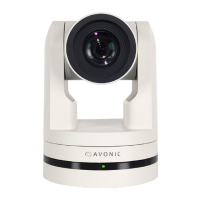Exposure
If you click in the field after the option ‘mode’, you will see that you have the following Exposure options: Auto,
Manual, SAE, AAE and Bright. These options are outlined below.
Auto Exposure Mode
In Automatic exposure mode, the camera determines the iris and shutter settings. See the settings below:
EV (Exposure Value): ON/OFF and Level
If the light conditions require this, you can create a quick adjustment to your current exposure settings without
actually changing the fundamental values like iris and shutter. When enabling this setting and using the EV level,
you can make the picture lighter. Take note that this setting is artificial.
Take care to not ‘overdo’ the settings or the picture will become washed out bright or too dark.
BLC (Back Light Compensation): ON/OFF
Compensation for having to film against bright light directly into the lens. Enabling the BLC (Backlight
Compensation) will make the filmed object slightly more visible, but it may cause overexposure in the background.
See the pictures below:
Figure 22: Camera Settings > Auto Expo (BLC OFF)
Figure 23: Camera Settings > Auto Expo (BLC ON)
Flicker
This setting handles the flickering of artificial lighting in its operating space. Under certain artifical lighting conditions it
is possible that you experience flickering in the picture. Depending on these lighting conditions you can reduce the
flickering by using 50hz, 60hz, or set this feature to OFF. See for more Anti-flickering on the website.
G.Limit
Gain limit is the maximum level of artificial brightness and contrast that the camera can automatically add to the
image. This setting will make a significant difference to the overall picture.
Be careful not to set the Gain Limit too high, because this setting add noise to the picture in dark areas and
produce a washed out, greyish picture.
DRC
Dynamic Range Compression has a similar effect on the picture as the above mentioned gain limit. The DRC works
by compressing the natural dynamic range of the image by taking out the darkest and lightest parts. This can be
a particular helpful setting when the light conditions are challenging. The differences should be clearly visible in
36

